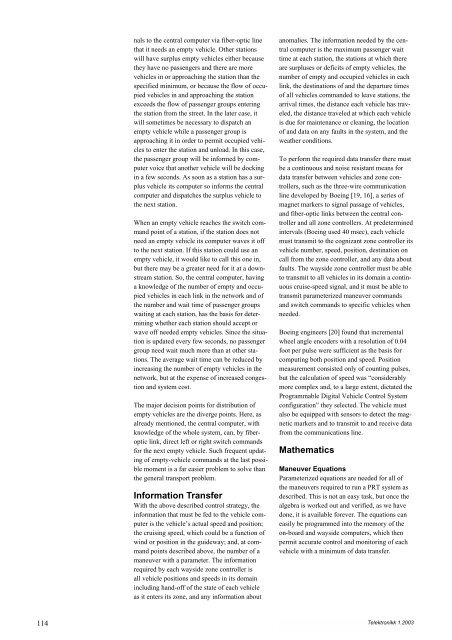Intelligent Transport Systems - Telenor
Intelligent Transport Systems - Telenor
Intelligent Transport Systems - Telenor
You also want an ePaper? Increase the reach of your titles
YUMPU automatically turns print PDFs into web optimized ePapers that Google loves.
114<br />
nals to the central computer via fiber-optic line<br />
that it needs an empty vehicle. Other stations<br />
will have surplus empty vehicles either because<br />
they have no passengers and there are more<br />
vehicles in or approaching the station than the<br />
specified minimum, or because the flow of occupied<br />
vehicles in and approaching the station<br />
exceeds the flow of passenger groups entering<br />
the station from the street. In the later case, it<br />
will sometimes be necessary to dispatch an<br />
empty vehicle while a passenger group is<br />
approaching it in order to permit occupied vehicles<br />
to enter the station and unload. In this case,<br />
the passenger group will be informed by computer<br />
voice that another vehicle will be docking<br />
in a few seconds. As soon as a station has a surplus<br />
vehicle its computer so informs the central<br />
computer and dispatches the surplus vehicle to<br />
the next station.<br />
When an empty vehicle reaches the switch command<br />
point of a station, if the station does not<br />
need an empty vehicle its computer waves it off<br />
to the next station. If this station could use an<br />
empty vehicle, it would like to call this one in,<br />
but there may be a greater need for it at a downstream<br />
station. So, the central computer, having<br />
a knowledge of the number of empty and occupied<br />
vehicles in each link in the network and of<br />
the number and wait time of passenger groups<br />
waiting at each station, has the basis for determining<br />
whether each station should accept or<br />
wave off needed empty vehicles. Since the situation<br />
is updated every few seconds, no passenger<br />
group need wait much more than at other stations.<br />
The average wait time can be reduced by<br />
increasing the number of empty vehicles in the<br />
network, but at the expense of increased congestion<br />
and system cost.<br />
The major decision points for distribution of<br />
empty vehicles are the diverge points. Here, as<br />
already mentioned, the central computer, with<br />
knowledge of the whole system, can, by fiberoptic<br />
link, direct left or right switch commands<br />
for the next empty vehicle. Such frequent updating<br />
of empty-vehicle commands at the last possible<br />
moment is a far easier problem to solve than<br />
the general transport problem.<br />
Information Transfer<br />
With the above described control strategy, the<br />
information that must be fed to the vehicle computer<br />
is the vehicle’s actual speed and position;<br />
the cruising speed, which could be a function of<br />
wind or position in the guideway; and, at command<br />
points described above, the number of a<br />
maneuver with a parameter. The information<br />
required by each wayside zone controller is<br />
all vehicle positions and speeds in its domain<br />
including hand-off of the state of each vehicle<br />
as it enters its zone, and any information about<br />
anomalies. The information needed by the central<br />
computer is the maximum passenger wait<br />
time at each station, the stations at which there<br />
are surpluses or deficits of empty vehicles, the<br />
number of empty and occupied vehicles in each<br />
link, the destinations of and the departure times<br />
of all vehicles commanded to leave stations, the<br />
arrival times, the distance each vehicle has traveled,<br />
the distance traveled at which each vehicle<br />
is due for maintenance or cleaning, the location<br />
of and data on any faults in the system, and the<br />
weather conditions.<br />
To perform the required data transfer there must<br />
be a continuous and noise resistant means for<br />
data transfer between vehicles and zone controllers,<br />
such as the three-wire communication<br />
line developed by Boeing [19, 16], a series of<br />
magnet markers to signal passage of vehicles,<br />
and fiber-optic links between the central controller<br />
and all zone controllers. At predetermined<br />
intervals (Boeing used 40 msec), each vehicle<br />
must transmit to the cognizant zone controller its<br />
vehicle number, speed, position, destination on<br />
call from the zone controller, and any data about<br />
faults. The wayside zone controller must be able<br />
to transmit to all vehicles in its domain a continuous<br />
cruise-speed signal, and it must be able to<br />
transmit parameterized maneuver commands<br />
and switch commands to specific vehicles when<br />
needed.<br />
Boeing engineers [20] found that incremental<br />
wheel angle encoders with a resolution of 0.04<br />
foot per pulse were sufficient as the basis for<br />
computing both position and speed. Position<br />
measurement consisted only of counting pulses,<br />
but the calculation of speed was “considerably<br />
more complex and, to a large extent, dictated the<br />
Programmable Digital Vehicle Control System<br />
configuration” they selected. The vehicle must<br />
also be equipped with sensors to detect the magnetic<br />
markers and to transmit to and receive data<br />
from the communications line.<br />
Mathematics<br />
Maneuver Equations<br />
Parameterized equations are needed for all of<br />
the maneuvers required to run a PRT system as<br />
described. This is not an easy task, but once the<br />
algebra is worked out and verified, as we have<br />
done, it is available forever. The equations can<br />
easily be programmed into the memory of the<br />
on-board and wayside computers, which then<br />
permit accurate control and monitoring of each<br />
vehicle with a minimum of data transfer.<br />
Telektronikk 1.2003
















